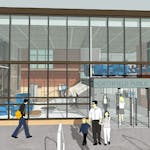English teacher Christina Anderson examines her school's laboratory to figure out how her writing students could use the equipment to do assignments. Physics teacher Chris Lee takes students to the lab and encourages them to find a niche and space. Jim Lynch forges partnerships with local businesses to help students become equipped to enter the workforce.
With shortages in skilled high-tech jobs, school districts like Rosemount-Apple Valley-Eagan are stepping out to bridge the divide between what they teach and what employers are looking for in workers.
For example, Apple Valley High School's "E3 STEM" program has partnered with local businesses and colleges on creative ways to connect high schoolers on STEM subjects — science, technology, engineering and math — and make the transition to college and the workforce smooth.
"Almost every career field will have some aspect of STEM in it," said Lynch, the "E3 STEM" program manager for Apple Valley High School. "And If we're not exposing our kids and not trying to get them to consider fields in STEM, they're kind of being cut out of some of the most high[est] paying, rapid growing job fields out there."
The "E3 STEM" — exploration, education and employment in science, technology, engineering and math — is designed to gauge students' interest in STEM-related fields, while giving them a jump-start in real-life work experiences and teamwork. Students have taken field trips to the Mayo Clinic to learn about respiratory health, spent time interning with major corporations and are building promotional materials for employers in their school's laboratory.
The program was launched nearly four years ago thanks to a $2.99 million Youth Career Connect grant, making the Rosemount-Apple Valley-Eagan School District one of just two in Minnesota to receive it. The federal grant helps school officials get the training they need to prepare students for STEM careers or college coursework and made a "Fab Lab," or fabrication lab, equipped with tools such as laser engravers, vinyl cutters, UV and 3-D printers, a reality.
Meanwhile, STEM programming is getting another national push. In September the White House directed the Department of Education to spend $200 million annually on grants that foster science, technology, engineering and math education.
Improving STEM education, especially for kids of color and girls, has been the focus in the school district, Lynch said. "They're severely underrepresented" in those fields.
The program, which only accepts students from 10th grade through 12th grade, has about 282 students this school year. Of those, 165 are girls and about 162 are students of color. The school has also launched a scholarship opportunity for girls to participate in business and STEM-related expeditions. This year, the school will send two female students to attend the Enterprising Women Conference in Miami.
Minnesota businesses are catching on to make their scouting ventures easy, arming young students with the basic skills they need to see in their workers. Apple Valley High School started out with just six business partners, but as the program's popularity grew among employers, nearly 30 businesses signed on to mentor students.
"It's not just learning about it from the teacher or learning about it from a textbook, it's engaging one-on-one with business people in the real world," said Kris Paulson, marketing director for BTM Global, a STEM partner at the Apple Valley High School.
Paulson is working with Anderson's "Writing for the 21st Century" class, where students are learning about business and technical writing while designing and creating promotional materials for BTM Global using the fabrication lab. After completing the project, students are going to show off their work at the company's headquarters in Apple Valley.
"After I had seen the Fab Lab, I thought it would be neat if my students could get connected with someone in the business world," Anderson said.
Lee said employers are yearning for students who are equipped with STEM skills. He said his goal is to fill that divide and give kids options, including those who pursue higher education at two-year colleges or go straight to the workforce.
Senior Cori Roberts, who plans to major in business administration when she goes to college, got the opportunity to be an intern at Uponor, a local manufacturing company last summer; she was trained as a project manager by a team of engineers.
Roberts oversaw an assembly-line type of project that fixed more than 1,000 defective thermostats. She said that experience gave her a solid starting point.
"It was quite life changing," Roberts said. "This was a really cool opportunity to see a potential career path as a project manager that I could pursue."
Faiza Mahamud • 612-673-4203





